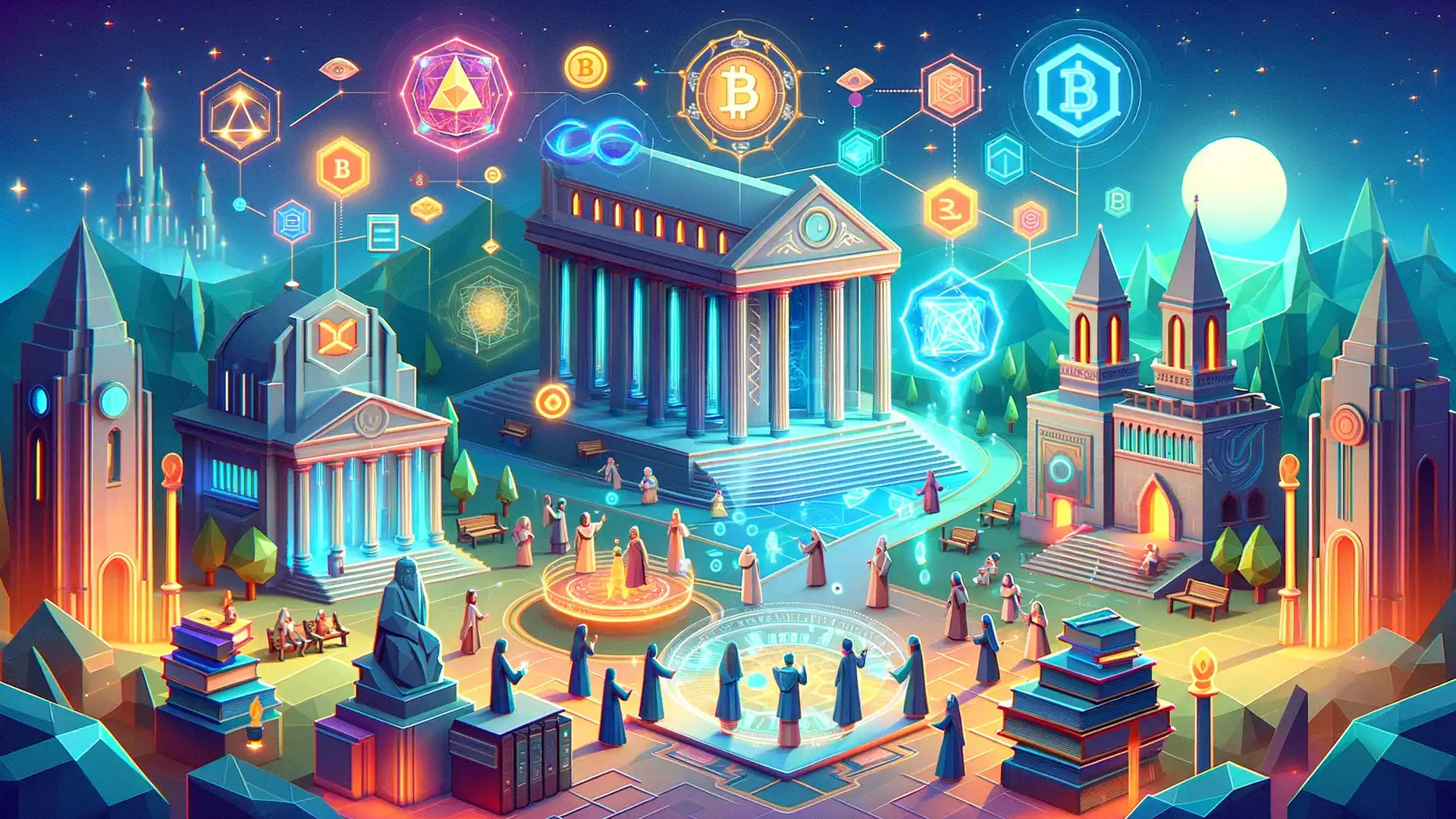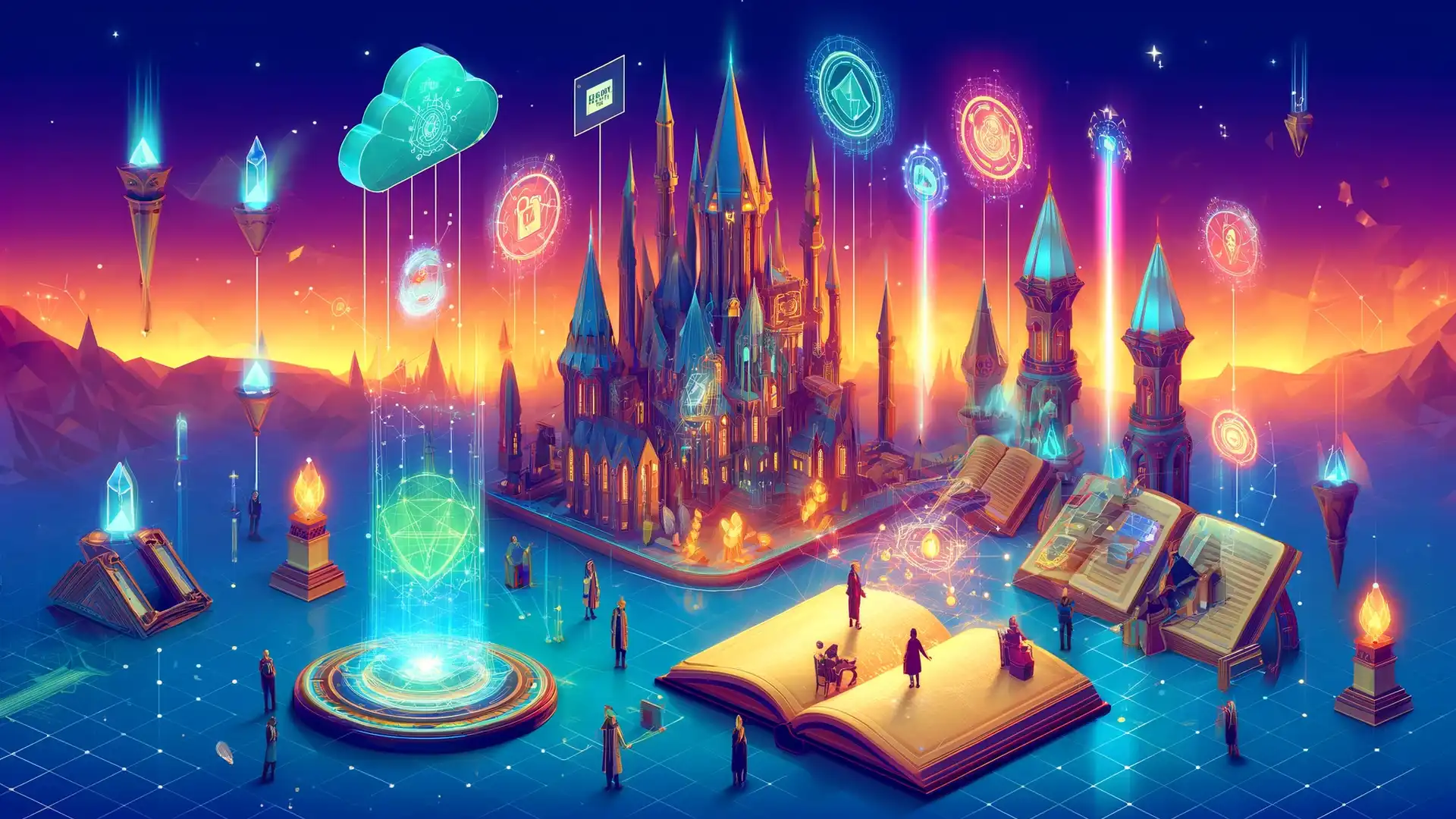NFT and Blockchain in Education: All the Basics, Definition, and Explanation for Beginners

 Author:
Artem Grigoriev
Author:
Artem Grigoriev
Empowering Education with NFTs and Blockchain: Fundamentals and Applications
Welcome to the dynamic intersection of education and cutting-edge technology. Here, the spotlight shines on Non-Fungible Tokens (NFTs) (unique digital items that establish ownership or confirm the authenticity of an item or content) and Blockchain (a decentralized system that records transactions across multiple computers). This chapter serves as your comprehensive guide. It illuminates how these technologies are becoming indispensable in reshaping the educational sector . As the demand for digital transformation in education intensifies, blockchain and NFTs offer practical solutions. These enhance security, efficiency, and accessibility. They pave the way for a more interconnected and streamlined educational experience.
📘 This article complements: "The Complete Guide to NFT Credentials". Explore it to find answers to all your questions;)
First, let's demystify some key terms. NFTs are digital assets. They signify ownership or authenticate a unique item or piece of content on the blockchain. Conversely, Blockchain serves as a decentralized ledger. It is a record-keeping system spread across numerous sites. It logs all transactions across a network of computers. This technology ensures a high level of security and transparency. The records are immutable (unchangeable) and publicly verifiable. It's essential to understand that the blockchain operates independently of any single entity. This significantly reduces the potential for manipulation. It bolsters its trustworthiness—a feature especially critical in education, where maintaining data integrity is paramount.
The synergy between NFTs and blockchain in education is profound. By integrating these technologies, educational systems can reach new heights of security and efficiency . For instance, NFTs can represent digital certifications. This allows a diploma to be issued as an NFT. It ensures it is unique, tamper-proof, and permanently verifiable across the blockchain network. Moreover, student artworks and other creative projects can be tokenized. This secures the creator's ownership rights. It makes these works easily shareable and verifiable. This shift from traditional methods to more dynamic, digital interactions enhances the value and accessibility of academic credentials.
A core benefit of blockchain technology lies in its foundational principles— decentralization, immutability, and transparency . These principles ensure that once educational records or achievements are logged onto a blockchain, they remain unaltered. This adds an unprecedented layer of security to educational records. It safeguards them from tampering and fraud. The Cambridge Centre for Alternative Finance highlights blockchain's potential as a foundational technology for maintaining data integrity across various sectors, including education. Read more about blockchain in education .
In practical terms, the adoption of NFTs and blockchain simplifies many traditional processes. Verifying academic credentials, for instance, can now be accomplished in seconds instead of weeks. Blockchain systems automate the issuance and verification of diplomas and certificates. This significantly reduces administrative burdens and the risk of fraudulent credentials . Schools and universities worldwide can access and confirm the authenticity of any certificate recorded on the blockchain. They do this without contacting the issuing institution. This global interoperability is recognized by leading educational technology experts. It is particularly advantageous in an increasingly globalized education market where students frequently move across borders.
💡 Note: Blockchain technology offers a transparent audit trail. This is a detailed and traceable record of all transactional activities. It ensures that every transaction can be tracked and verified. This upholds the integrity of educational data. The U.S. Department of Education is exploring blockchain's use to enhance transparency and reduce costs in managing educational data and credentials. Explore U.S. Department of Education blockchain initiatives .

As we delve deeper into applications, numerous institutions have already started implementing these technologies. For example, blockchain-based systems are utilized to securely store student records and academic achievements. They maintain data integrity and make educational achievements portable and universally recognizable. Major universities around the globe are adopting blockchain to issue verifiable digital diplomas to graduates. This enhances the ease and authenticity of post-graduate transactions with employers and other educational institutions.
The potential of NFTs extends beyond just certificates. They are also used to create unique, digital student portfolios. These can include a variety of media types. They showcase student growth and learning in multifaceted ways. These digital portfolios offer a more holistic representation of a student's educational journey. They provide potential employers and educational institutions with a rich, immutable record of skills and achievements. This effectively bridges the gap between educational output and labor market needs.
To facilitate educators and institutions in beginning their journey into the world of NFTs and blockchain, a variety of resources are available. These include beginner-friendly tutorials, comprehensive case studies, and platforms specifically designed for educational purposes. These resources aim to demystify the technology and make it accessible. They enable educators to experiment with and ultimately adopt these tools. Educational products are being developed to specifically cater to the needs of the education sector. They provide both theoretical and practical knowledge necessary for integration.
This chapter opens the door to a world where education is more secure, efficient, and tailored to meet the challenges of the digital age. Embracing blockchain and NFTs could very well be the key that unlocks a new paradigm in how educational achievements are recorded, shared, and recognized globally. The integration of these technologies into educational practices not only prepares students for a digital future. It also revolutionizes the administration and dissemination of knowledge. This sets a new standard for educational excellence and integrity.
💡 Tip: Starting small by integrating blockchain-based projects into the curriculum not only enhances learning but also provides students with hands-on experience with these future-forward technologies. Encouraging educators to participate in blockchain workshops and seminars can also foster a solid foundational understanding. This prepares an environment ready for technological integration. Blockchain education resources .

Overcoming Challenges and Looking to the Future in Education's Digital Transformation
The journey toward integrating Non-Fungible Tokens (NFTs) (unique digital assets that establish ownership or authenticity of unique items or content) and Blockchain (a technology that records information across a network of computers in a way that prevents alteration) into education involves overcoming various hurdles. This chapter explores both the challenges and the emerging opportunities that promise to redefine the educational landscape . Every technological advancement brings a mix of challenges and opportunities. This marks a critical stage in its adoption. Understanding these challenges and being resourceful are key. They help harness the full potential of these innovative technologies in educational settings.
One of the primary barriers is the technological complexity inherent in blockchain and NFTs. For many educators and administrators, the prospect of using these technologies can seem daunting. However, user-friendly blockchain platforms have emerged. These platforms are designed for non-technical users. They simplify the user experience while retaining the core functionalities of blockchain. Such accessibility is crucial for broad adoption. It lowers the entry barrier for educators and educational institutions eager to explore blockchain technology. Learn more about user-friendly blockchain platforms .
Privacy concerns regarding student data represent another significant challenge. The decentralized nature of blockchain raises questions about the security and privacy of sensitive information. To tackle this, blockchain systems incorporate advanced encryption methods. These methods secure data by transforming it into unreadable code, along with privacy-preserving technologies. These enhancements are vital. They maintain trust and legality when using blockchain for sensitive data. Ensuring the privacy and security of student information is paramount. It builds confidence among stakeholders in the educational ecosystem.
Moreover, the digital divide —the gap between those who have access to modern information and communication technology and those who do not—presents a significant challenge in achieving equitable education. To combat this, targeted policies and initiatives are necessary. They provide digital access to underprivileged and remote communities. Ensuring that no student is left behind in the digital shift is essential. Bridging this divide is crucial not only for fair access to educational resources. It also ensures that blockchain and NFT technologies benefit all sectors of society equally, fostering inclusivity and equality in the digital transformation of education.
💡 Note: Effective strategies for overcoming these barriers include educational outreach and technology training programs. Institutions can leverage partnerships with technology providers and government bodies. These partnerships facilitate these programs, enhancing community engagement and technological fluency across demographics.

This chapter also highlights several case studies where blockchain and NFTs have been successfully integrated within educational systems. For instance, some institutions have adopted blockchain to automate the credential verification process. This drastically reduces the time and resources spent on these administrative tasks. Another case study illustrates how NFTs are used to engage students by tokenizing educational achievements. This motivates learners and provides a tangible way of showcasing their learning progress. These real-world applications demonstrate the practical benefits and scalability of blockchain technologies in diverse educational settings. They show how these technologies can streamline operations and enhance student engagement.
Looking forward, the potential for NFTs and blockchain in education continues to evolve. Trends such as gamification (applying game-design elements to learning activities to make them more engaging) are being enhanced by blockchain technologies. These technologies allow for secure, transparent tracking of student achievements and active participation. Furthermore, personalized learning experiences are being revolutionized by NFTs. These can represent custom learning pathways and achievements. They adapt education to fit the needs and pace of each student. Such innovations signify a shift towards more student-centered learning environments. Here, technology plays a key role in personalizing and enhancing educational experiences. This opens new avenues for addressing diverse learning styles and needs. It provides a more customized and impactful educational journey for each student.
Another exciting development is the role of Decentralized Autonomous Organizations (DAOs) (virtual organizations run by a set of rules encoded on blockchain technology and operated collectively without centralized leadership) in education. DAOs could potentially democratize educational governance. They give teachers, students, and parents a voice in decision-making processes through blockchain-based voting systems. The potential of DAOs to transform educational governance could lead to more inclusive and responsive educational policies and practices. This empowers all stakeholders in the educational community.
The chapter concludes with a forward-looking perspective, urging educators and institutional leaders to stay abreast of these technologies. It emphasizes the importance of continuous professional development and adaptive policy-making . These are crucial to fully leverage the benefits of blockchain and NFTs in education. As digital transformation progresses, staying informed and adaptable will be key. This proactive approach is essential for educators to not only keep pace with technological advancements but also to lead and shape the future of education in the digital age.
💡 Tip: Consider joining or forming learning communities focused on blockchain and NFT technologies in education. These groups can provide support, resources, and collaboration opportunities. Engaging in such communities can accelerate learning curves, foster innovation, and facilitate the exchange of best practices. This collaborative approach enhances the collective understanding and effective implementation of blockchain and NFTs in education. It potentially transforms the landscape of educational technology.

Practical Applications of NFT and Blockchain in Education and Beyond
The Benefits of NFT-Based Credentials
Comparing NFT Credentials to Traditional Paper Credentials: Which Is Better and Why?
Types of NFT Credentials: Which One to Choose and Why?
The Power of NFT Rewards: Boosting Engagement and Loyalty in Education
